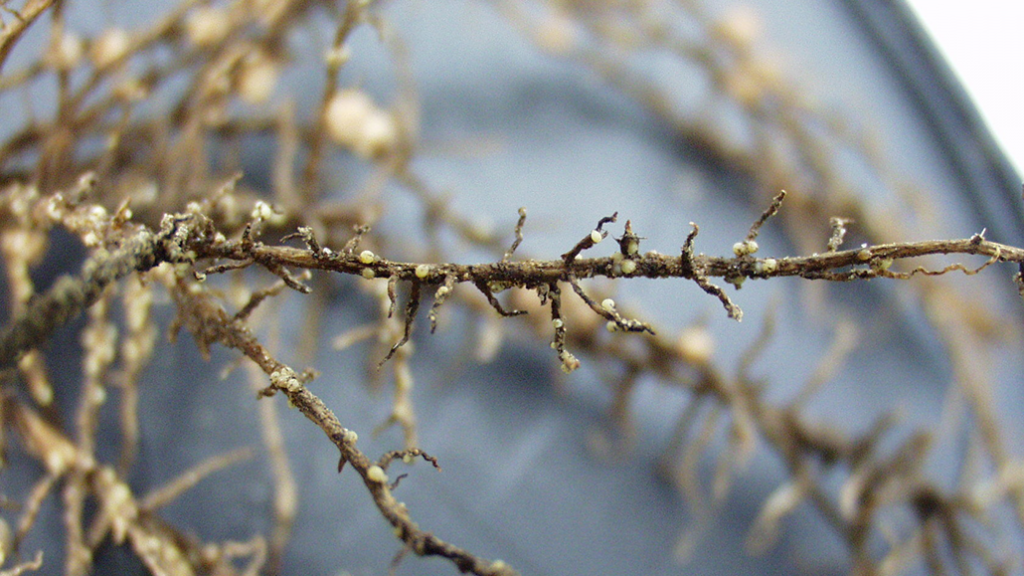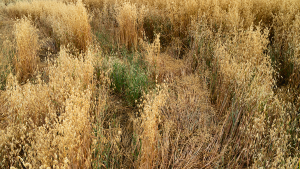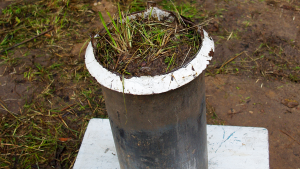The SCN crisis
FINDING SOLUTIONS

SOYBEAN CYST NEMATODE (SCN), a devastating root-attacking field pest, is estimated to have cost farmers in Ontario and the United States $1 billion (USD) annually between 2010 and 2019. While Ontario farmers have access to resistant varieties, their effectiveness has started to wane. Simultaneously, the range of SCN continues to grow across the province.
Continued efforts to find genetic and field management solutions are ongoing, including a renewal of participation in the cross-border SCN coalition by the University of Guelph and the Ontario Ministry of Agriculture, Food and Rural Affairs (OMAFRA) with funding support from Grain Farmers of Ontario.
CURRENT SITUATION
Ontario SCN losses range from $30 to $53 million (CAD) year over year, even though management options are available. Overall, -limiting biological threat to soybeans, with losses expected to increase over time.
Like glyphosate and problem weeds, most soybean varieties once considered resistant to SCN appear increasingly susceptible to the pest. Indeed, research from OMAFRA shows many fields planted with resistant varieties appear no different than those planted with susceptible ones. This affects yield, and provides greater opportunity for SCN to proliferate.
SCN is also linked with Brown Stem Rot and Sudden Death Syndrome. If simultaneously present with one of the diseases, yield loses can be even more significant. Yield losses incurred due to SCN can often go unnoticed, despite costing an average of $15 per acre.
“SCN has several sources. It has been difficult historically to get resistant varieties without measurable yield consequences,” says Milad Eskandari, associate professor and plant breeder with the University of Guelph, and one of the researchers contributing to the coalition.
“Developing high yielding cultivars using other SCN sources, rather than the PI 88788 variety, has been challenging and, therefore, most of the current SCN-resistant lines are derived from one single source.”
INCREASED AWARENESS
Set to continue until spring 2024, SCN coalition participants will share research and lessons in managing the pest in order to achieve a number of objectives — evaluating the effectiveness of SCN sources of resistance via management trials being the first.
Second comes evaluations of nematicides and other products for SCN, plus corn nematode. Driving wider grower awareness of SCN, its corn-attacking counterpart, and integrated pest management practices comprises another component. This will be accomplished through extension and resource sharing, as well as the SCN coalition’s website (www.thescncoalition.com).
Another objective involves establishing Ontario-specific benchmarking data for SCN losses via a grower survey. Results of the survey are intended to help determine future research priorities, and general focus, of the SCN coalition.
“Like our research into Sudden Death Syndrome, what we’re doing now is about getting ahead of the problem,” says Eskandari. “More options will give growers the performance, and provide breeders and seed companies with alternative options for their research and cultivar development programs.”
This project is funded by the Canadian Agricultural Partnership, a five-year investment by Canada’s federal, provincial and territorial governments.
PRIORITIES OF THE SCN COALITION
- Develop integrated disease and pest management strategies with a focus on preventing trait and pesticide resistance in key diseases, including SCN, corn nematodes, and Sudden Death Syndrome.
- Survey and monitor weeds, diseases, and insect pests to identify changes in population structure and resistance to pest control strategies.
- Develop best management practices for seed treatments, while determining their economic value.
IDENTIFICATION AND CONTROL
Managing Soybean Cyst Nematode (SCN) is more than just planting a SCN resistant soybean variety. SCN populations are becoming resistant to the PI 88788 resistance gene. SCN is also showing up in regions that were not previously known to have SCN.
Symptoms of SCN are:
- Stunting and yellowing above ground.
- Early senescence or maturation of the crop can be an indirect symptom of SCN.
- Root stunting, discolouration, and fewer nodules below-ground .
- Cysts (adult females) of SCN can be seen on roots without magnification.
- How to control SCN:
- Crop rotation with non-host crops such as corn, wheat, and other non-legume crops.
- Rotate soybean varieties and different SCN sources of resistance.
- Avoid soil movement if field does not have SCN through good sanitation practices.
- Test your field every three to five years to know SCN numbers.
Sample soils in the fall if there is thought to be an issue. Even if the sample result comes back as zero, SCN may still be present just not at a level that can be detected. •











